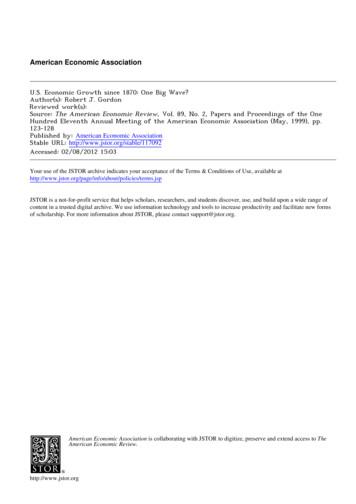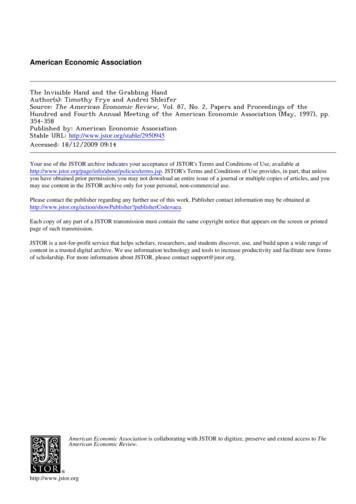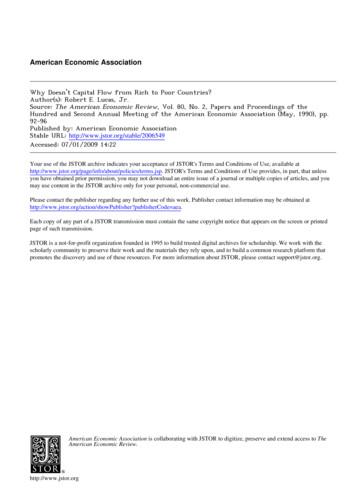American Economic Association - University Of North .
American Economic AssociationR&D Spillovers and the Geography of Innovation and ProductionAuthor(s): David B. Audretsch and Maryann P. FeldmanSource: The American Economic Review, Vol. 86, No. 3 (Jun., 1996), pp. 630-640Published by: American Economic AssociationStable URL: http://www.jstor.org/stable/2118216 .Accessed: 30/07/2014 10:25Your use of the JSTOR archive indicates your acceptance of the Terms & Conditions of Use, available at ms.jsp.JSTOR is a not-for-profit service that helps scholars, researchers, and students discover, use, and build upon a wide range ofcontent in a trusted digital archive. We use information technology and tools to increase productivity and facilitate new formsof scholarship. For more information about JSTOR, please contact support@jstor.org.American Economic Association is collaborating with JSTOR to digitize, preserve and extend access to TheAmerican Economic Review.http://www.jstor.orgThis content downloaded from 152.23.75.172 on Wed, 30 Jul 2014 10:25:38 AMAll use subject to JSTOR Terms and Conditions
R&DSpillovers and the Geography of Innovationand ProductionBy DAVID B. AUDRETSCH AND MARYANN P. FELDMAN*More than most othereconomic activities,innovationand technologicalchange dependupon new economic knowledge.Thus, PaulRomer (1986), Paul Krugman(1991a, b),and Gene Grossmanand ElhananHelpman(1991), among others,have focused on therole that spillovers of economic knowledgeacrossagentsand firmsplay in generatingincreasing returns and ultimately economicgrowth. In fact, several recent studies haveidentifiedthe existence of spatially-mediatedknowledgespillovers.An importantfindingofAdam B. Jaffe (1989), Zoltan Acs et al.(1992, 1994), andFeldman(1994a, b) is thatinvestmentin R&D by privatecorporationsand universities"spills over" for third-partyfirmsto exploit.If the abilityto receiveknowledge spilloversis influencedby distancefromthe knowledgesource, then geographicconcentrationshould be observed,especially inindustries where knowledge spillovers arelikely to play a moreimportantrole. The purpose of this paperis to examinethe extenttowhich industrialactivityclustersspatiallyandto linkthisgeographicconcentrationto the existenceof knowledgeexternalities.Of course,as Jaffe et al. (1993) point out, one obviousexplanationwhy innovativeactivity in someindustriestendsto clustergeographicallymorethanin otherindustriesis thatthe locationofproductionis more concentratedspatially.Thus,in explainingwhy the propensityfor innovativeactivityto clustergeographicallyvaries acrossindustries,we need firstto explain,and then to controlfor, the geographicconcentrationof the locationof production.As Alfred Marshall (1920) and, laterKrugman(1991b) argue,there may be geographicboundariesto informationflows orknowledgespillovers,particularlytacitknowledge, among the firms in an industry.Although the cost of transmittinginformationmay be invariantto distance,presumablythecost of transmittingknowledgerises with distance.Thatis, proximityand locationmatter.While thereis considerableevidencesupporting the existenceof knowledgespillovers,neitherJaffe(1989), Jaffeet al. (1993), norAcset al. (1992, 1994), andFeldman(1994a) actually examinethe propensityfor innovativeactivityto clusterspatially.But implicitin theknowledgeproductionfunctionmodel is theassumptionthat innovative activity shouldconcentrategeographicallyin those industrieswherethe directknowledge-generatinginputs* Audretsch:are the greatestand where forschungandthe Centrefor EconomicPolicyResearch, overs arethe most prevalent.No one, to date,Reichpietschufer50, D-10785Berlin,Germany;Feldman: r Policy Studies,Johns HopkinsUniversity,dustrialactivityto clusterspatially.WhileoneBaltimore,MD 21218. This article was writtenwhileof the centralthemesin the industrialorganiMaryannFeldmanwas visiting at the Heinz School ofPublicPolicyandManagement,CarnegieMellonUniver- zationliteratureis to explainthedegreeof consity. We thankRichardBaldwin,Paul Krugman,James centrationof economic activity within anMarkusen,and participantsat the CEPRConferenceonindustry (F. M. Scherer and David Ross,the "Locationof EconomicActivity:New Theoriesand1990), the focus has typicallybeen on the exNew Evidence,"17-20 December,1993,Vigo,Spain,fortheiruseful comments.We also thankJim Adams,Zvitent of wyn Hall, Frank Lichtenberg,Richard and establishmentswithin a single spatialNelsonandMike Schererandthe participantsin the disunit-the country.The emergingimportancecussionat the 1995 AEA Meetings.We wouldalso likeoflocationas a unitof observationarguesforto thankthe anonymousrefereesforusefulcommentsandexamining both productionand innovationsuggestions.Gail within a geographiccontext.We empirically630This content downloaded from 152.23.75.172 on Wed, 30 Jul 2014 10:25:38 AMAll use subject to JSTOR Terms and Conditions
VOL. 86 NO. 3AUDRETSCHAND FELDMAN: GEOGRAPHYOF PRODUCTION631test for the importanceof geographiclocationto differenttypes of industriesby linkingthegeographicconcentrationin manufacturingindustries to industry specific characteristics,mostnotablytherelativeimportanceof knowledge spillovers.In the following section of this paper,weexaminethe spatialdistributionof innovativeactivityas well as the geographicconcentration of production.An empirical model isspecified in Section II, and the results arepresentedin Section HII.In the final section,we provide a summaryand conclusion.Theempiricalevidence suggests that, even aftercontrollingfor the degreeof geographicconcentrationin production,innovativeactivitytends to cluster more in industries whereknowledgespilloversplay a decisiverole. Althoughsuch industriesalso tend to exhibit agreatergeographicconcentrationof production, the resultssuggestthatthe propensityforinnovativeactivityto clusteris more attributable to the role of knowledgespilloversandnot merely the geographicconcentrationofproduction.used by Acs and Audretsch(1988, 1990) toanalyze the relationshipsbetween firm sizeand technologicalchange, and marketstructureand technologicalchange,and by Acs etal. (1992, 1994), Feldman(1994a, b), andFeldmanand RichardFlorida(1994) to examinethe geographyof innovation.We adoptthe stateas the spatialunitof observation.While this is at best a crudeproxyof the relevanteconomicmarket,2it does haveone obviousappealotherthanthatit conformsto a numberof data sources-the most relevantunitof policy-makingis at the level of thestate. Still, statesare certainlynot an entirelysatisfactoryunitof observationfor theanalysisof spatialphenomena.The analysesof spatialprocessesare handicappedby a lack of datafor what might be consideredto be the dbe madeif datasourcesidentifyinginnovationactivity at the city or county levelwere madeavailable.Using the citation data base describedabove, an innovationis attributedto the statein whichthe establishmentresponsiblefor thedevelopmentof that innovation is located.I. TheSpatialDistributionof InnovationSome innovationsare, in fact, developedbyandProductionsubsidiariesor divisions of companies withheadquartersin other states. Since headquarTo measurethe spatial distributionof in- ters may announcenew productinnovations,novative activitywe rely on the most recent the data base discriminatesbetween the loand most ambitiousmajordatabase thatpro- cation of the innovatingestablishmentandvides a directmeasureof innovativeactivity. the location of the larger, stra- (Edwardsand Gordon, 1984). For our purtion (the SmallBusinessAdministration'sIn- poses, the stateidentifierof the establishmentnovationData Base or the SBIDB) compiled is usedto investigatethe spatialdistributionofa database of 8,074 commercialinnovations innovation.Of thetotalnumberof innovationsintroducedin the UnitedStatesin 1982.A pri- recordedin the database, 4,200 were manuvate firm, The FuturesGroup,compiledthe facturinginnovationswith informationspecidata and performedquality control analyses fying location.3for the United StatesSmall BusinessAdminFigure 1 shows the distributionof innovaistration.A databaseconsistingof innovations tionsby states.Californiais the statein whichby four-digitstandardindustrialclassification(SIC) industrieswas formed from the newproductannouncementsections in over 1002As Krugman(1991b p. 57) emphasizes, "Statestechnology, engineering and trade journals aren'treallythe rightgeographicalunits,"becauseof thethat span every industry.'These data were lack of concordancebetweeneconomicmarketsandpo'A detailed description of the U.S. Small Business Administration'sInnovation Citation Data Base can be foundin chapter two of Acs and Audretsch (1990), as well asin Acs and Audretsch (1988).liticalunits.'The SBIDBcontainsa totalof 4,476 innovationsinmanufacturingindustries.Of these,thereare276 innovationswhicharenot ethe UnitedStatesor did not havecompletelocationinformation.This content downloaded from 152.23.75.172 on Wed, 30 Jul 2014 10:25:38 AMAll use subject to JSTOR Terms and Conditions
632THE AMERICANECONOMICREVIEWJUNE 1996Counts of Innovationby State100050010025050Numberof InnovationsFIGURE1.25 10 2Source:U.S. Small BusinessAdministration InnovationData, 1982Citation-a (3)NUMBER OF INNOVATIONS BY STATEthe greatest number of innovations were registered, followed by New York, New Jersey,and Massachusetts. A particularlystriking feature shown in Figure 1 is that the bulk of innovative activity in the United States occurson the coasts, and especially in California andin New England. By contrast, no innovativeactivity is registered in certain Midwesternstates such as North Dakota, South Dakota,Montana, and Wyoming.4 States in the traditional manufacturing belt such as Ohio, Illi-4 Of course, simply comparing the absolute amount ofinnovative activity across states ignores the fact that themanufacturingbase of some states is larger than others.Presumably one of the most importantdeterminantsof innovative activity is the location of manufacturingactivity.Additional information on the geographic distribution ofthe innovation data can be found in Feldman (1994b) andFeldman and Florida ( 1994).nois, Michigan, and Pennsylvania are not at allparticularlyinnovative. Thus, while the location of manufacturingactivity may explain thespatial distribution of innovative activity tosome degree, it is certainly not the only factor.This presentation of the aggregate geographic distribution of innovative activity inthe United States obscures the propensity forinnovative activity to cluster spatially withinspecific industries.Thus, the distributionof innovative activity for the seven most innovativefour-digit standard industrial classification(SIC) industries is shown in Table 1. A striking result is that the spatial concentration ofinnovative activity in particular industries isconsiderably greater than for all of manufacturing. For example, in the computer industry,342 of the 821 innovations recorded, or 41.7percent, are in California. And an additional10 percent are recorded in Massachusetts.This content downloaded from 152.23.75.172 on Wed, 30 Jul 2014 10:25:38 AMAll use subject to JSTOR Terms and Conditions
633AUDRETSCHAND FELDMAN GEOGRAPHYOF PRODUCTIONVOL. 86 NO. ers(n 821)3823Process control instruments(n 464)3662Radio and TV communicationsequipment(n 339)Semiconductors(n 172)36743842Surgical appliances(n 152)2834Phannaceuticals(n 127)3825Measuring instrumentsforelectricity(n 115)StateNumber ofinnovationsState share of industryinnovationsIndustry share ofstate innovationsCaliforniaMassachusettsNew YorkTexasNew JerseyIllinoisCaliforniaMassachusettsNew YorkPennsylvaniaIllinoisCaliforniaNew YorkMassachusettsCaliforniaMassachusettsTexasNew JerseyCaliforniaPennsylvaniaNew JerseyNew YorkPennsylvaniaMichiganCaliforniaMassachusettsNew .88.98.64.77.710.11.74.111.73.94.17.13.816.92.9a The SIC is the standardindustrialclassification used in the U.S. Small Business Administration'sInnovation CitationData Base.'The total number of innovations recorded in the four-digit industry is listed in parentheses.Thus, these two statesalone accountfor overone half of all the innovationsin the computerindustry.At the same time, the last columnindicatesthatinnovationsin the computerindustryaccountedfor slightly more than onethirdof all the innovationsin Californiaandalittle morethanone fifthof all innovationsinSimilarly,nearly40 percentofMassachusetts.the 127innovationsin thedrugindustry(pharmaceuticals)were recordedin New Jersey,while an additional14 percentwere made inNew York.Thus,overone-halfof pharmaceutical innovationswerein the New Jersey-NewYork area.At the same time, pharmaceuticalinnovationsaccountfor over one tenthof allinnovationsregisteredin New Jersey.To measurethe extent to which manufacturing in specific industriesis concentratedgeographicallyand the extentto which innovative activity tends to cluster spatially,wefollow Krugman's(1991b) exampleand calculate Gini coefficients for the geographicof innovativeactivityandfortheconcentrationTable 2 provideslocationof manufacturing.''The locationalGini coefficientsfor productionarebasedon industryvalue-added.We calculatethe amountof value-addedin an industryand state dividedby thenationalvalue-addedfor the industry.This ratiois norvaluemalizedby the stateshareof totalmanufacturingaddedin orderto accountfor the overalldistributionofactivity.An industrywhich is not geomanufacturinggraphicallyconcentratedmore than is reflectedby theof vea coefficientof 0. Theclosertheindustrycoefficientthe industryconcentratedis to 1, themoregeographicallywouldbe. Casesin whichstateor industrydatahavebeensuppressedareomittedfromthe analysis.The Ginicoefficientsforinnovationarebasedon thecountof innovationin a stateandindustryandarecalculatedin a suponrequest.This content downloaded from 152.23.75.172 on Wed, 30 Jul 2014 10:25:38 AMAll use subject to JSTOR Terms and Conditions
634THE AMERICANECONOMICREVIEWTABLE 2-GEOGRAPHIC CONCENTRATIONOF PRODUCTIONAND INNOVATIVEACTiVITYFORMANUFACrURINGSECTORS(MEAN GINI COEFFICIENTS)aManufacturingsectorFood aperPrintingChemicalsPetroleumRubber andplasticsLeatheraValue 4)0.3932(0.1952)0.0646(0.1 1 19)Standarddeviations are given in parentheses.the weightedmeanGinicoefficientsforvalueadded, employment,and innovativeactivitywithineach broadtwo-digitSIC manufacturing sector.Those sectorsexhibitingthe greatest geographicconcentrationof tationequipment, textiles, food and beverages,leatherandchemicals.By contrast,thosemanufacturingsectorsexhibitingthe highestpropensity for innovative activity to truments,andelectronics.Thatthepropensityfor innovativeactivityto spatiallyclustercannot be simply explainedby the geographicconcentrationof thelocationof manufacturingactivityis evidentfromTable2. Thispointstothe importanceof controllingfor the geographic concentrationof productionin explainingthe propensityfor innovativeactivityto spatiallycluster.II. TheModelWhyshould innovations tend to cluster spatially more in some 'industries than in otherJUNE 1996industries?Oneobviousansweris simplythatthe locationof productionis moregeographically concentratedin some industriesthaninothers.Thisraisesthe issue of endogeny.Jaffeet al. (1993) identify two relatedcriticalissues which must be consideredin trying toidentifywhy thepropensityfor innovativeactivity to clusterspatiallyvaries acrossindustries. First, the extent to which the locationof productionis geographicallyconcentratedmust be controlledfor, so that the relevantquestion becomes: even after accounting forthe geographic concentration of the production location, why does the propensity forinnovative activity to cluster vary across in-dustries?And second,in tryingto accountforthe degreeto whichthe locationof productionis geographicallyconcentrated,an importantfactoris the role which knowledgespilloversplay in the industry.It is only afterthe geographicconcentrationof productionhas beencontrolledfor, that the degree to which innovativeactivityclustersspatiallycan be addressed.Thus, to explain the propensityforinnovativeactivityto clusterspatiallywe begin with the extent to which productionisgeographicallyconcentrated.While it is not possibleto directlymeasurethe extent to which knowledgeexternalitiesexist, as Kenneth J. Arrow (1962) andKrugman(1991a) point out, it is possible toidentify industriesin which new economicknowledgeplays a relativelymore importantrole. This is done on the basis of the industryR&D intensity,or R&D-salesratio.The crucial assumptionwe make here is Arrow's(1962) argumentthat knowledge spilloversaremoreimportantin, andreflectedat leasttosome degreeby, highlyR&D-intensiveindustries. By contrast,such knowledgeexternalities, while perhapsstill present,play a lessimportantrole wherethe creationof new economicknowledge,as reflectedby R&Dintensity, is negligible. Thus, the location ofproductionwouldbe expectedto be moreconcentratedin thoseindustrieswhereknowledgespilloversare prevalent,that is in industrieswhichareR&D intensive.Similarly,skilled workersendowedwith ahigh level of humancapitalare a mechanismby whicheconomicknowledgeis transmitted.The greaterthe extent to which the industryThis content downloaded from 152.23.75.172 on Wed, 30 Jul 2014 10:25:38 AMAll use subject to JSTOR Terms and Conditions
VOL. 86 NO. 3635AUDRETSCHAND FELDMAN: GEOGRAPHYOF PRODUCTIONTABLE 3-DESCRIPTION OF VARIABLESVariableGini of productionGini of innovationNatural Skilled laborUniversity researchDescription and sourceGini coefficient of four-digit SIC industry value-added across states,weighted by national value-added for the industry in 1982 (U.S.Department of Commerce, Bureau of the Census, 1982 EconomicCensus).Gini coefficient of four-digit SIC industry count of innovationsacross states, weighted by national innovation count for theindustry in 1982 (Edwards and Gordon, 1984).Share of total industry inputs purchased from mining andagriculturein 1976 (Input-outputdata as provided by U.S.InternationalTrade Commission databank).Mean size of the largest establishments accounting for one half ofthe industry value-of-shipments divided by industry value ofshipments in 1982 (U.S. Departmentof Commerce, Bureau ofthe Census, 1982).Radius of the mean distance shipped in 1967 (CommodityTransportSurvey of the United States Census of Transportationfor 1967, taken from Weiss [1991]).Industryexpenditures on research and development divided by salesin 1977 (Line of Business Survey, U.S. Federal TradeCommission, 1977).Share of industry employment accounted for by professi
American Economic Association R&D Spillovers and the Geography of Innovation and Production Author(s): David B. Audretsch and Maryann P. Feldman Source: The American Economic Review, Vol. 86, No. 3 (Jun., 1996), pp. 630-640 Published by: American Economic Association
American Economic Association U.S. Economic Growth since 1870: One Big Wave? Author(s): Robert J. Gordon Reviewed work(s): Source: The American Economic Review, Vol. 89, No. 2, Papers and Proceedings of the One Hundred Eleventh Annual Meeting of the American Economic Association (May, 1999), pp. 123-128 Published by: American Economic Association
American Economic Association The Invisible Hand and the Grabbing Hand Author(s): Timothy Frye and Andrei Shleifer Source: The American Economic Review, Vol. 87, No. 2, Papers and Proceedings of the Hundred and Fourth Annual Meeting of the American Economic Association (May, 1997), pp. 354-358 Published by: American Economic Association
American Economic Association The Peculiar Economics of Bureaucracy Author(s): William A. Niskanen Source: The American Economic Review, Vol. 58, No. 2, Papers and Proceedings of the Eightieth Annual Meeting of the American Economic Association (May, 1968), pp. 293-305 Published by: American Economic Association
American Economic Association Why Doesn't Capital Flow from Rich to Poor Countries? Author(s): Robert E. Lucas, Jr. Source: The American Economic Review, Vol. 80, No. 2, Papers and Proceedings of the Hundred and Second Annual Meeting of the American Economic Association (May, 1990), pp. 92-96 Published by: American Economic Association
American Economic Association Negative Time Preference Author(s): George Loewenstein and Drazen Prelec Source: The American Economic Review, Vol. 81, No. 2, Papers and Proceedings of the Hundred and Third Annual Meeting of the American Economic Association (May, 1991), pp. 347-352 Published by: American Economic Association
American Economic Association Beyond Markets and States: Polycentric Governance of Complex Economic Systems Author(s): Elinor Ostrom Source: The American Economic Review, Vol. 100, No. 3 (JUNE 2010), pp. 641-672 Published by: American Economic Association
American Economic Association Lifetime Earnings and the Vietnam Era Draft Lottery: Evidence from Social Security Administrative Records Author(s): Joshua D. Angrist Source: The American Economic Review, Vol. 80, No. 3 (Jun., 1990), pp. 313-336 Published by: American Economic Association
ARALING PANLIPUNAN I (Effective and Alternative Secondary Education) MODYUL 8 PAGSIBOL NG KAMALAYANG PILIPINO BUREAU OF SECONDARY EDUCATION Department of Education DepEd Complex, Meralco Avenue Pasig City . 1 MODYUL 8 PAGSIBOL NG KAMALAYANG PILIPINO Ang Pilipino ay likas na mapagtiis at mapagbigay kung kaya’t ang mga pagmamalabis at pang-aabuso ng mga Espanyol sa kanilang karapatan ay tiniis .























